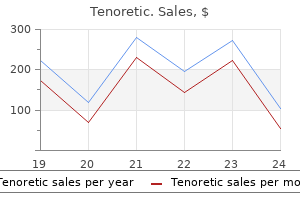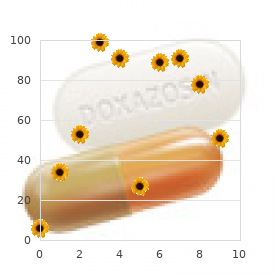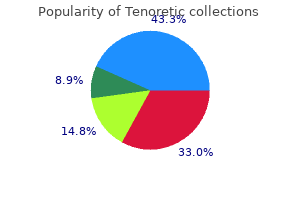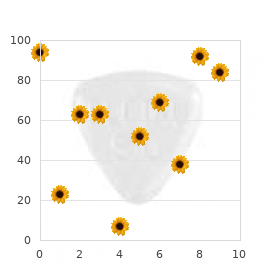Only $0.52 per item
Tenoretic dosages: 100 mg
Tenoretic packs: 60 pills, 90 pills, 120 pills, 180 pills, 270 pills, 360 pills
In stock: 867
8 of 10
Votes: 312 votes
Total customer reviews: 312
Description
Oral mucosa forms an important protective barrier between the external environment of the oral cavity and internal environments of the surrounding tissues alternative medicine order 100mg tenoretic amex. It is resistant to the pathogenic organisms that enter the oral cavity and to indigenous microorganisms residing there as microbial flora. Epithelial cells, migratory neutrophils, and saliva all contribute to maintaining the health of the oral cavity and protecting the oral mucosa from bacterial, fungal, and viral infections. The protective mechanisms include several salivary antimicrobial peptides, the -defensins expressed in the epithelium, the -defensins expressed in neutrophils, and the secretory immunoglobulin A (sIgA). However, in individuals with immunodeficiency or those undergoing antibiotic therapy, in which the balance between microorganisms and protective mechanisms is disrupted, oral infections are rather common. The striated muscle of the tongue is arranged in bundles that generally run in three planes, with each arranged at right angles to the other two. This arrangement of muscle fibers allows enormous flexibility and precision in the movements of the tongue, which are essential to human speech as well as to its role in digestion and swallowing. This form of muscle organization is found only in the tongue, which allows easy identification of this tissue as lingual muscle. The apex of the V points posteriorly and is the location of the foramen cecum, the remnant of the site from which an evagination of the floor of the embryonic pharynx occurred to form the thyroid gland. Fungiform and filiform papillae are on the anterior portion of the dorsal tongue surface. The uneven contour of the posterior tongue surface is attributable to the lingual tonsils. The lingual papillae and their associated taste buds constitute the specialized mucosa of the oral cavity. Four types of papillae are described: filiform, fungiform, circumvallate, and foliate. Filiform papillae are distributed over the entire anterior dorsal surface of the tongue, with their tips pointing backward. They appear to form rows that diverge to the left and right from the midline and that parallel the arms of the sulcus terminalis. Taste buds are present in the stratified squamous epithelium on the dorsal surface of these papillae. Structurally, the filiform papillae are posteriorly bent conical projections of the epithelium. These papillae do not possess taste buds and are composed of stratified squamous keratinized epithelium. Fungiform papillae are slightly rounded, elevated structures situated among the filiform papillae. A highly vascularized connective tissue core forms the center of the fungiform papilla and projects into the base of the surface epithelium.

Qinghaosu (Sweet Annie). Tenoretic.
- Dosing considerations for Sweet Annie.
- How does Sweet Annie work?
- What is Sweet Annie?
- Are there safety concerns?
- Malaria, AIDS-related infections, anorexia, arthritis, bacterial and fungal infections, bruises, common cold, constipation, diarrhea, fever, gallbladder disorders, indigestion, jaundice, night-sweats, painful menstruation, psoriasis, scabies, sprains, tuberculosis, and other conditions.
Source: http://www.rxlist.com/script/main/art.asp?articlekey=96738
As a result of actin polymerization at their leading edge medicine rock cheap 100mg tenoretic otc, cells extend processes from their surface by pushing the plasma membrane ahead of the growing actin filaments. The leading-edge extensions of a crawling cell are called lamellipodia; they contain elongating organized bundles of actin filaments with their plus ends directed toward the plasma membrane. These processes can be observed in many other cells that exhibit small protrusions Unlike those of microfilaments and microtubules, the protein subunits of intermediate filaments show considerable diversity and tissue specificity. Intermediate filaments also do not typically disappear and re-form in the continuous manner characteristic of most microtubules and actin filaments. The long, straight actin filament cores or rootlets (R) extending from the microvilli are cross-linked by a dense network of actin filaments containing numerous actin-binding proteins. The network of intermediate filaments can be seen beneath the terminal web anchoring the actin filaments of the microvilli. Mechanism of brush border contractility studied by the quick-freeze, deep-etch method. Although the various classes of intermediate filaments differ in the amino acid sequence of the rod-shaped domain and show some variation in molecular weight, they all share a homologous region that is important in filament self-assembly. Intermediate filaments are assembled from a pair of helical monomers that twist around each other to form coiled-coil dimers. Each tetramer, acting as an individual unit, is aligned along the axis of the filament. The ends of the tetramers are bound together to form the free ends of the filament. This assembly process provides a stable, staggered, helical array in which filaments are packed together and additionally stabilized by lateral binding interactions between adjacent tetramers. Intermediate filaments are a heterogeneous group of cytoskeletal elements found in various cell types. Intermediate filaments are self-assembled from a pair of monomers that twist around each other in parallel fashion to form a stable dimer. Two coiled-coil dimers then twist around each other in antiparallel fashion to generate a staggered tetramer of two coiled-coil dimers. Each tetramer, acting as an individual unit, aligns along the axis of the filament and binds to the free end of the elongating structure. This staggered helical array is additionally stabilized by lateral binding interactions between adjacent tetramers. These are the most diverse groups of intermediate filaments and are called keratins (cytokeratins). Keratins only assemble as heteropolymers; an acid cytokeratin (class 1) and a basic cytokeratin (class 2) molecule form a heterodimer. Each keratin pair is characteristic of a particular type of epithelium; however, some epithelial cells may express more than one pair. According to new nomenclature, keratins are divided into three expression groups: keratins of simple epithelia, keratins of stratified epithelia, and structural keratins, · · · · also called hard keratins.

Specifications/Details
Small granule cells usually occur singly in the trachea and are sparsely dispersed among the other cell types treatment kidney cancer symptoms generic 100mg tenoretic visa. They are difficult to distinguish from basal cells in the light microscope without special techniques such as silver staining, which reacts with the granules. The nucleus is located near the basement membrane; the cytoplasm is somewhat more extensive than that of the smaller basal cells. A second cell type produces polypeptide hormones such as serotonin, calcitonin, and gastrin-releasing peptide (bombesin). Some are present in groups in association with nerve fibers, forming neuroepithelial bodies, which are thought to function in reflexes regulating the airway or vascular caliber. Basal cells serve as a reserve cell population that maintains individual cell replacement in the epithelium. Basal cells tend to be prominent because their nuclei form a row in close proximity to the basal lamina. Although nuclei of other cells reside at this same general level within the epithelium, they are relatively sparse. In individuals with asthma, the basement membrane is also thicker and more pronounced, especially at the level of the bronchioles. G G the lamina propria, excluding that part just designated as basement membrane, appears as a typical loose connective tissue. It is very cellular, containing numerous lymphocytes, many of which infiltrate the epithelium. Their surface is characterized by small blunt microvilli that give a stippled appearance to the cell at this low magnification. Basement Membrane, Lamina Propria, and Submucosa A thick "basement membrane" is characteristic of tracheal epithelium. At their free surface, they contain numerous cilia that, together, give the surface a brush-like appearance. This is owing to the linear aggregation of structures referred to as basal bodies, located at the proximal end of each cilium. Although basement membranes are not ordinarily seen in H&E preparations, a structure identified as such is seen regularly under the epithelium in the human trachea. It usually appears as a glassy or homogeneous light-staining layer approximately 25 to 40 m thick. Electron microscopy reveals that it consists of densely packed collagenous fibers that lie immediately under the epithelial basal lamina. Structurally, it can be regarded as an unusually thick and dense reticular lamina and, as such, is part of the lamina propria. The Clara cell, as illustrated here, is interposed between the brush cell and the small granule cell. Adjacent, is the brush cell containing blunt microvilli, which are distinctive features of this cell. Cytoplasm of the brush cell shows a Golgi apparatus, lysosomes, mitochondria, and glycogen inclusions.
Syndromes
- Numbness or tingling that spreads down an arm or leg
- Severely dry eyes
- Do you pick your nails or rub the fingers or toes chronically?
- Cranial MRI or cranial CT scan
- Females 12.3–15.3 g/dL
- Hematoma (blood accumulating under the skin)
- Loss of appetite, low energy, and fatigue

The surface of the membrane that is backed by extracellular space is called the E-face; the face backed by the protoplasm (cytoplasm) is called the P-face medicine 773 cheap 100 mg tenoretic with mastercard. The specimen is then coated, typically with evaporated platinum, to create a replica of the fracture surface. In scanning electron microscopy, the electron beam does not pass through the specimen but is scanned across its surface. They are three-dimensional in appearance and portray the surface structure of an examined sample. For mineralized tissues, it is possible to remove all the soft tissues with bleach and then examine the structural features of the mineral. Scanning is accomplished by the same type of raster that scans the electron beam across the face of a television tube. Electrons reflected from the surface (backscattered electrons) and electrons forced out of the surface (secondary electrons) are collected by one or more detectors and reprocessed to form a high-resolution three-dimensional image of a sample surface. Other detectors can be used to measure X-rays emitted from the surface, cathodoluminescence of molecules in the tissue below the surface, and Auger electrons emitted at the surface. It is a nonoptical microscope that works in the same way as a fingertip, which touches and feels the skin of our face when we cannot see it. The sensation from the fingertip is processed by our brain, which is able to deduce surface topography of the face while touching it. The upper surface of the cantilever is reflective, and a laser beam is directed off the cantilever to a diode. This arrangement acts as an "optical lever" because extremely small deflections of the cantilever are greatly magnified on the diode. As the tip moves up and down in the z-axis as it traverses the specimen, the movements are recorded on the diode as movements of the reflected laser beam. A piezoelectric device under the specimen is activated in a sensitive feedback loop with the diode to move the specimen up and down so that the laser beam is centered on the diode. As the tip dips down into a depression, the piezoelectric device moves the specimen up to compensate, and when the tip moves up over an elevation, the device compensates by lowering the specimen. An extremely sharp tip on a cantilever is moved over the surface of a biologic specimen. The feedback mechanism provided by the piezoelectric scanners enables the tip to be maintained at a constant force above the sample surface. As the tip scans the surface of the sample, moving up and down with the contour of the surface, the laser beam is deflected off the cantilever into a photodiode. The photodiode measures the changes in laser beam intensities and then converts this information into electrical current. Feedback from the photodiode is processed by a computer as a surface image and also regulates the piezoelectric scanner. In contact mode (left inset), the electrostatic or surface tension forces drag the scanning tip over the surface of the sample.
Related Products
Additional information:
Usage: q.i.d.

Tags: 100mg tenoretic order with mastercard, tenoretic 100 mg buy with mastercard, generic 100mg tenoretic fast delivery, buy 100mg tenoretic with mastercard
Customer Reviews
Real Experiences: Customer Reviews on Tenoretic
Hjalte, 29 years: Initially, these cells arrange themselves in a series of cylinders called endoneurial tubes. The medulla forms the centrally located axis of the hair shaft; it does not always extend through the entire length of the hair and is absent from some hairs. The pattern is the same as that for permanent teeth, so the numbering begins from the second upper right molar and finishes with the second lower right molar. Intermediate cells constitute the amplifying compartment of the intestinal stem cell niche.
Hurit, 28 years: Note that the three basic types of secretions are shown in cells of the exocrine glands. Each spinal nerve arises from the spinal cord by rootlets, which merge together to form dorsal (posterior) and ventral (anterior) nerve roots. Autoradiography Autoradiography makes use of a photographic emulsion placed over a tissue section to localize radioactive material within tissues. This group of pharmacologic agents binds to estrogen receptors and acts as an estrogen agonist (mimicking estrogen action) in bone; in other tissues, it blocks the estrogen receptor action (acting as an estrogen antagonist).
Porgan, 56 years: The free surface epithelium of each papilla is thick and has a number of secondary connective tissue papillae projecting into its undersurface. If the exposure to an allergen is persistent (for instance, by a dog-owning patient who is allergic to dogs), it can result in chronic allergic inflammation. The tunica adventitia, or outermost connective tissue layer, is composed primarily of longitudinally arranged collagenous tissue and a few elastic fibers. Primary cilia (monocilia) are solitary projections found on almost all eukaryotic cells.



